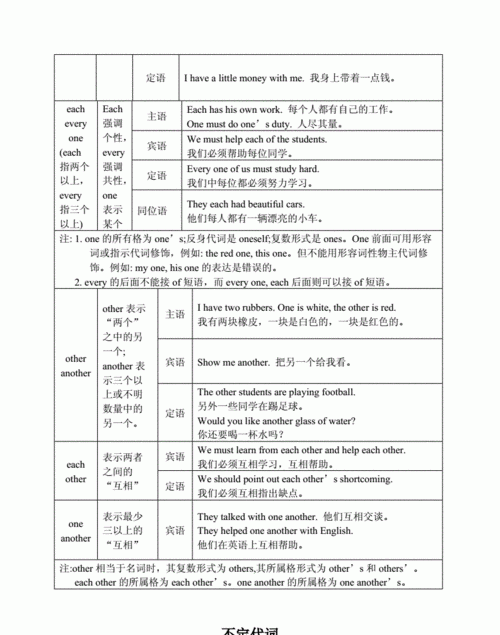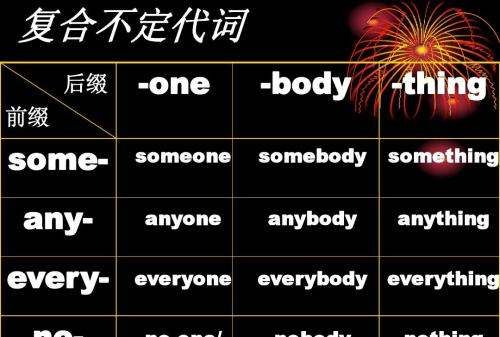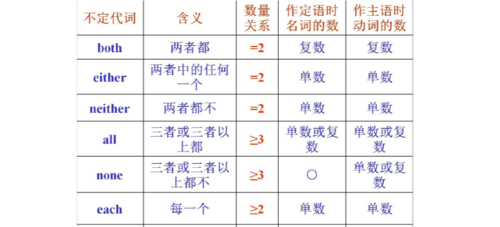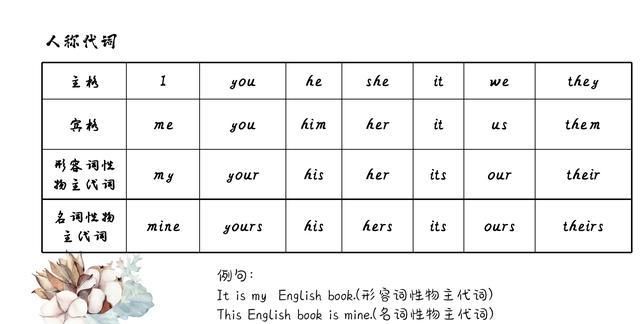本文目录
形容词作不定代词后置定语
还有any,all ,both,many,few 后面要接复数形式。

不定代词的三种基本用法
不定代词有:something、somebody、someone、somewhere、anything、anybody、anyone、anywhere、nothing、nobody、no one。
everything、everybody、everyone、everywhere、all、each、both、much、many、a little、a ew、others、another、none、one、either、 neither。
不定代词可以分为很多种类,它的功能与用法也非常丰富,不定代词大都可以代替名词和形容词,在句中作主语、宾语、表语、定语和状语。
不定代词的句法功能
1、作主语
例: Both(of us) are right.
(我们)两人都对。
2、作宾语
例: There is room for all of us.
我们所有的人全坐得下。
3、作表语
例: That’s nothing.
没什么。
4、作定语
例: You may take either road.
两条路你走哪条都行。

扩展资料
1、除every 和no外,不定代词既可用作名词,也可用作形容词。every和no在句中只能作定语.
例如:I have no idea about it.
我没有任何主意。
2、all指三者以上,是“都”的意思。all的单复数由它所修饰或指代的名词的单复数决定。
例如:All goes well.
一切进展得很好。
all 通常不与可数名词单数连用,如:不说 all the book,而说 the whole book.
但all可与表时间的可数名词单数连用,如 all day,all night,all the year;但习惯上不说all hour,all century.
all还可以与一些特殊的单数名词连用,如 all China,all the city,all my life,all the way.
3、both都,指两者。both 与复数动词连用,但 both… and…可与单数名词连用。both,all 都可作同位语,其位置在行为动词前,be 动词之后。如果助动词或情态动词后面的实义动词省去,则位于助动词或情态动词之前。
Who can speak Japanese? We both (all) can.
4、neither两者都不,neither作主语时,谓语动词用单数。
作定语与单数名词连用,但neither… nor 用作并列连词,可与复数名词连用。其谓语采用就近原则。
5、如前句是否定式从句,则主句用neither,而不用 nor。
If you don't do it,neither should I.
如果你不干,我也不干。
6、如后连续有几个否定句式,则用nor,不用neither。
He can't sing,nor dance,nor skate.
7、some 某些,一些,某个
不定代词some可以代替名词和形容词,常用在肯定句中作主语、宾语、定语等。作定语时,它可以修饰可数名词(单、复数皆可)和不可数名词。
例如:some are doctors,some are nurses.
有些人是医生,有些人是护士。
8、any一些,任何
不定代词any可以代替名词和形容词,常用在否定句或疑问句中作主语、宾语、定语等。作定语时,它可以修饰可数名词(多为复数)和不可数名词。
例如:there isn’t any ink in my pen.
我的钢笔没有墨水。(作定语)
9、不定代词any有时也可以用在肯定句中,表示"任何的"。
例如:you may come at any time;I’ll be home the whole day.
你任何时候来都行,我整天都将呆在家里。
10、不定代词any也可以用作副词,做状语,表示程度。
例如:is he any better today?
他今天好一点了吗?
11、none 无人或无
不定代词none的含义和all物相反,和no one,not any同义,但其用法相当于名词,在句子中一般作主语或宾语。它代替不可数名词作主语时,谓语动词用单数形式;代替可数名词作主语时,谓语动词用单、复数皆可。
例如:one of the problems is /are easy to solve.
这些问题没有一个是容易解决的。(作主语, 代替可数名词)
12、each 每个,各自的
不定代词each指每一个人或事物的个别情况,甚至指这些个别情况各不相同。它在句中可以作主语、宾语、定语和同位语。
例如:he gave the children two apples each.
她给了每个小孩两个苹果。(作the children的同位语)
13、every 每个,每一的,一切的
不定代词every有"全体"的意思,和all的意义相近,但只能作定语。
不定代词后面加什么
不定代词指的是那些不指明代替任何特定名词或形容词的代词。不定代词的种类很多。其中,some(一些),any( 一些,任何),no(无),every(每个)与one,body,thing合成的代词使用最频繁。
例:① someone,somebody(某人), something(某物)
② anybody,anyone(任何人), anything(任何物)
③ nobody,no one(无人), nothing(没有东西)
④ everyone,everybody(每人,人人),everything(每个事物)
前一组词常用于肯定句,而后一组词常用于否定句和疑问句。
例:① theres something interesting in this room.这个房间有些有趣的东西。
② i cant hear anything in this room.在这房间里我听不到任何声音。
③ was there anything difficult for you to understand?你有什么不懂的吗?
④ somebody knocked at the door when i was cooking.我做晚饭的时候,有人敲门。
nobody,no one,nothing等词也表示否定,分别相当于 not anybody,not anything等。
(2)用法:代词在句中作主语、 宾语、 表语、 定语等。 something,somebody, anything,anybody作主语时,通常视为单数。
例:① something is wrong with the bus.汽车出故障了。
② there isnt anything in the room. 房间里什么也没有。
2 不定代词的修饰词位置
形容词修饰something,anything,nothing等词与汉语不同, 要放在不定代词的后面,这些修饰词可以是形容词,也可以是动词不定式,也可两者都有即形容词后面跟动词不定式:
例:①there is something wrong with the clock.闹钟出了毛病。
②theres nothing new in todays newspaper.今天报纸上没有什么特别新闻。
③ive something to tell you.我有事要对你说。
④did the child ask for anything to drink?那小孩要过喝的东西吗?
⑤do you have anything nice to eat?你有没有好吃的东西?
⑥he has nothing good to show us.他没有好东西给我们看。
3 不定代词some的用法
不定代词some表示不定的量“一些”,通常与名词连用(也可以单独使用),用来修饰可数名词的复数形式和不可数名词。 some常用于肯定句,在否定及疑问句中常用any“一些,什么,任何的”来表示不定的量。
例:①id like some bananas/milk.我想要些香蕉/牛奶。
②i dont like any orange/eggs.我不喜欢喝橙汁/吃鸡蛋。
③do you like any apples/bread?你喜欢吃些苹果/面包吗?
4 反身代词的用法
(1)反身代词的构成
反身代词是由第一、 二人称的形容词性物主代词和第三人称代词宾格加词尾self(用于单数)或selves(用于复数)构成。具体见下表:
第一人称第二人称第三人称单数 myselfyourselfhimself,herself,
itself复数ourselvesyourselvesthemselves(2)反身代词的用法
反身代词在句中可作多种成份。如:宾语、表语、补语、同位语等。本节着重讲解它作宾语的用法。
1> 作及物动词buy,enjoy,help,teach, wash, dress, hurt,make等词的宾语。
例:① mr green is rich and he always buys himself many good things. 格林先生很有钱,他总是给自己买许多好东西。
② did you enjoy yourself at the party?晚会上你玩得高兴吗?
③ help yourselves to some meat,please!请随便吃些肉。
④ thomas edison built himself a lab.托马斯·爱迪生自己建成了一个实验室。
⑤ my father taught himself english when he was a child.当我父亲还是个孩子时,他就自学英语。
⑥ he could not wash himself or get dressed.他自己不能洗漱,也不能穿衣服。
⑦ i hope she didnt hurt herself.我希望她没有摔伤自己。
⑧ the boy is too young to dress himself.这个男孩年龄太小不能给自己穿衣服。
⑨ are you making yourself a plane?你在为自己制作飞机吗?
2>作介词after,to,by,for等词的宾语。
例:① we can look after ourselves while our parents are away.当我们的父母亲不在时,我们能自己照顾自己。
② the granny said to herself,“what shall i do?”老奶奶自言自语道:“我该怎么办?”
③ we cant leave the baby by himself.我们不能把这婴儿单独留下来。
此外,反身代词可以作主语和宾语的同位语。
例:①last monday i saw dr wang himself. 上星期一我见到了王医生本人。
②i myself made the birthday cake.我自己做的生日蛋糕。
③he washed the clothes himself.他自己洗衣服。
2 语法句型
1 something for breakfast(lunch,supper,dinner,picnic...)
该结构中,for为介词,后常接表示餐名的名词,与该结构连用的动词常有bring,find,have,buy等,翻译时,通常把for译成相应的动词。
例:① shall i bring food for a picnic?要我拿些食物供野餐吃吗?
② i think we must buy some meat for supper.我认为我们得买些肉供晚餐吃。
③ what did li lei have for breakfast yesterday?昨天李雷早餐吃了些什么?
2 have(has)been to...
这是一个表示现在完成时态的结构,由助动词have(has)+过去分词构成,been为be的过去分词,to为介词,后接地点名词,“have(has)been to”意思是“去过什么地方,但现在不在那儿。”
例:① have you been to america?你去过美国吗?
② he has been to the factory.他去过那家工厂。
如果表示“去过那儿(这儿)”即been后面接副词, 则不要介词to。
例:weve never been there before.我们以前从没去过那儿。
3 be alone
alone为形容词,和be构成be alone,作表语,意思是“单独”、“孤单”相当于by oneself.
例:① are you alone when you are at home?你在家时孤单吗?
② my brother is very alone.我弟弟很孤独。
此外alone有时也作副词。
例:i went alone.我一个人去的。
alone也可做定语修饰名词,意思是“仅仅, 只有”但只能放在所修饰词的后面。
例:the girl alone was in the classroom.唯有这个女孩在教室里。
4 hear sth./sb.do sth./that...
在该结构中,hear为及物动词,后跟名词或代词, 表示“听见……,听到……”。
例:① we heard a knock at the door.我们听见敲门声。
② i can hear something.我能听到某东西的响声。
hear还可跟不带to的不定式复合结构,表示“听见……做了……”。
例:we often hear her sing this song.我们经常听见她唱这首歌。
hear后也可跟从句,意思是“听说……”。
例:i hear that he will visit the great wall tomorrow.
我听说他明天要参观万里长城。
5 pull...out of...和pull...up from...
在pull...out of...结构中pull为及物动词,意思是“拉、拖”,后接out of...表示“把……从……拖(拉)出来。”
例:① he pulled his brother out of bed.他把弟弟从床上拖下来。
② lets pull the boat out of the water.我们把这船从水中拖出来吧。
与此相似地还有pull...up from.... 意思是“把……从……拉上来”。
例:the children pulled the boat up from the water.
孩子们把小船从水里拉上来。
pull的反义词为push,相反的结构为push...out(of)意思是“把……从……推出去”。
例:lets push the heavy thing out of the house.
我们把这重物从屋子里推出去吧。
6 no longer
no longer意为“不再”,作状语,侧重表示时间关系,句中谓语动词通常是延续性动词。
例:①you are no longer a little child.你已不再是小孩子了。
②i can no longer wait here.我不能在这儿再等候了。
no longer等于not any longer。如例②可说成“i cant wait here any longer”。
3 学习中应注意的问题
1 bring和take的区别
动词bring一般表示“带来、拿来、送来”等,意指由远而近。
例:① have you brought a message from her?你从她那里带来了消息吗?
② i will bring them to you some day.将来某一天我将把他们给你带来。
动词take一般表示“拿走、带走”与bring相反。
例:① dont forget to take your bag with you when you go. 你走的时候别忘了带走你的包。
② she takes her children to school by car.她用车送孩子们上学。
但是当说话人和听话人处在不同的地方(如打电话时),bring所指的运动的方向既朝向说话人又朝向听话人。写信时也这样用。
例:—come and stay for the weekend and bring your wife.“带上夫人来这儿过周末吧。”
—thanks.id like to. can we bring the children,too?“谢谢,我一定去。我们也可以带上孩子吗?”
2body,one,thing+形容词
单个形容词作定语修饰复合不定代词 something, anything, somebody, anybody,anyone等时, 其位置必须后置。
例:① there is something new in todays newspaper.在今天的报纸上有些新鲜事。
② do you know anybody else(别的)?你认识别的什么人吗?
③ do you have anything interesting to tell me?你有些有趣的事情要告诉我吗?
④ can you see anything unusual in the picture?在图画上你能看见不同寻常的东西吗?
3 some也可以用于一般问句中
通常some 用于肯定句,any用于否定句或疑问句中,但是在表示请求、 劝诱或期望得到肯定回答的问句中用some代替any。
例:① wont you have some tea? 难道你不想喝茶吗?
② will you give me some bread?请给我一些面包好吗?
③ do you have some paper?你有些纸吗?
同步训练
ⅰ选择填空
1.“is there____interesting in todays newspaper(报纸)”? “no,interesting.”
a.something,something b.anything,nothing c.anything,anything d.nothing,something
2.“___away all the plates and fruit here,please.” said the mother to ling ling.
a.take,bringb.bring,takec.bring,bringd.take,take
3.what did they have___ their picnic?
a.to b.of c.for d.on
4.the man pulled the boy___ the river.
a.out b.out of c.in d.with
5.she is twenty years old.she___ a child.
a.is not longer b.no longer is c.is no longer d.not longer is
ⅱ从下面的方框中选择正确的词语填空
somebody nobody something anybody everybody anything someany nothing
1.—“excuse me, may i have ___water,please?”
—“sorry,there isn___there.”
2.i listened carefully but i didnt hear
3.my watch doesnt work. there must be___wrong with it.
4.___can do the work, even a child. its too easy.
5.i called you at home yesterday afternoon,but___ answered the phone.
6.—“is there enough food for___ in the room?”
—“i dont think so.___has to go and get some more.”
7.“your son is very ill.im afraid i can do___ ”, said the doctor.
ⅲ句型转换,一空一词
1.there is nobody in the classroom.
there is ___ ___in the classroom.
2.the workers are pulling the jeep out of the water.
the workers are pulling the jeep ___ ___the water.
3.our old house isnt there any longer.
our old house___ ___ ___ there.
答案与详解
ⅰ.1.b anything 用在疑问句中,答语是否定句,因此选否定意义的否定代词。
2.a away 暗示应配合使用take,here暗示应配合使用bring。
3.c 句型have sth. for ...。
4.b 此句属于pull...out of ...结构。
5.c no longer 用于be之后实意动词之前。
ⅱ.1.some、 any, some 用在表肯定的疑问句中。
2.anything, anything用于否定句中。
3.something, something用于肯定句。
4.anybody, anybody表示任何一个人。
5.noboby, but表示转折,前后两句意思相反。
6.everybody,somebody 7.nothing
ⅲ.1.not anybody, nobody=not anybody。
2.up from, pull...out of ...与pull...up from意思相近。
3.is no longer, no longer =not ... any longer

德语不定代词的总结
你的提问当中本身有些概念混淆:
不管用aller/alles/alle修饰不可数名词,亦或用alle修饰可数名词复数,all-都是形容词,而非不定代词,楼上的朋友用详细的例子说明,all-既可以修饰可数名词,也可以修饰不可数名词,意思不变,都是”所有的“意思;
不定代词alles代物,单数变位,alle代人,复数变位,简单举例如下:
Alles ist weg. 所有东西都不见了。
Alle sind schon da.所有人都已经到了。
祝学习愉快!

以上就是关于不定代词后面加名词什么形式 ,形容词作不定代词后置定语的全部内容,以及不定代词后面加名词什么形式 的相关内容,希望能够帮到您。
